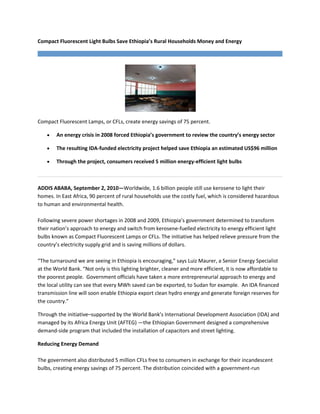
Compact Fluorescent Light Bulbs Save Ethiopia
- 1. Compact Fluorescent Light Bulbs Save Ethiopia’s Rural Households Money and EnergyCompact Fluorescent Lamps, or CFLs, create energy savings of 75 percent. An energy crisis in 2008 forced Ethiopia’s government to review the country’s energy sector The resulting IDA-funded electricity project helped save Ethiopia an estimated US$96 million Through the project, consumers received 5 million energy-efficient light bulbsADDIS ABABA, September 2, 2010—Worldwide, 1.6 billion people still use kerosene to light their homes. In East Africa, 90 percent of rural households use the costly fuel, which is considered hazardous to human and environmental health.Following severe power shortages in 2008 and 2009, Ethiopia’s government determined to transform their nation’s approach to energy and switch from kerosene-fuelled electricity to energy efficient light bulbs known as Compact Fluorescent Lamps or CFLs. The initiative has helped relieve pressure from the country’s electricity supply grid and is saving millions of dollars.“The turnaround we are seeing in Ethiopia is encouraging,” says Luiz Maurer, a Senior Energy Specialist at the World Bank. “Not only is this lighting brighter, cleaner and more efficient, it is now affordable to the poorest people. Government officials have taken a more entrepreneurial approach to energy and the local utility can see that every MWh saved can be exported, to Sudan for example. An IDA financed transmission line will soon enable Ethiopia export clean hydro energy and generate foreign reserves for the country.”Through the initiative–supported by the World Bank’s International Development Association (IDA) and managed by its Africa Energy Unit (AFTEG) —the Ethiopian Government designed a comprehensive demand-side program that included the installation of capacitors and street lighting.Reducing Energy Demand The government also distributed 5 million CFLs free to consumers in exchange for their incandescent bulbs, creating energy savings of 75 percent. The distribution coincided with a government-run awareness campaign called “Save Energy,” which highlighted the benefits of saving energy at home and work.Local Addis Ababa resident Tsigereda Habtemariam replaced five bulbs in her family home with CFLs. “They provide better lighting, create a pleasant feeling and the bill decreases from month to month,” she said. Within three months of launching the initiative, with half the bulbs distributed, the Ethiopian Electric Power Corporation (EEPCo) succeeded in reducing peak demand by 80 percent. Generating this energy using emergency diesel generators would have cost the country an estimated US$100 million, according to Maurer. The cost of the CFL distribution amounted to just US$4 million.Expanding Access to Poor, Rural AreasBenefits of the CFL program go beyond an expanded power grid. The poor benefit most. Low-income households, consuming about 20 kWh per month, can reduce their electricity consumption by 55 percent through efficient lighting. During a power crisis, when countries are shedding load or leasing expensive generators, the rationale for deploying CFLs is even more compelling. One CFL, costing US$0.83 cents, saves US$3.5 per month for the power sector. This effort is part of a larger energy portfolio in Ethiopia called the Accelerated Electricity Access (Rural) Expansion which has seen Ethiopia increase access from 10 percent to 40 percent in villages. The World Bank funding is in the form of an International Development Association interest-free loan of US$700 million over the past five years. Other donors include the African Development Bank, and Agence française de Développement. A portion of the World Bank’s financing will study the disposal of old CFLs and improving local injera bread baking stoves, which consume high energy. Based on the success of this project, the Ethiopian government has reduced import duties on some energy efficiency equipment and has been drafting a law banning the use of incandescent light bulbs. If approved, this will be the first law of its kind in a developing country. For more information on the Ethiopia Electricity Expansion Project, contact Luiz Maurer (lmaurer@worldbank.org) or Raihan Elahi (relahi@worldbank.org)<br />